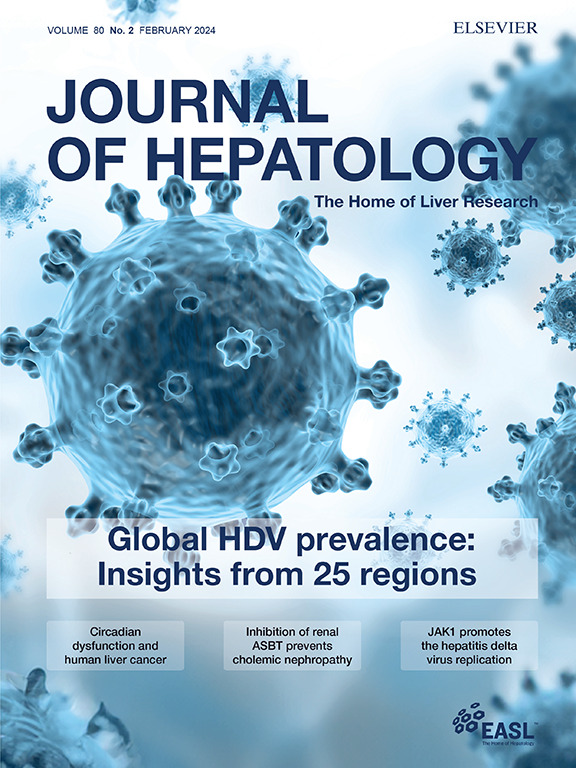时空肝脏动力学塑造肝细胞异质性和体内基因工程的影响
IF 33
1区 医学
Q1 GASTROENTEROLOGY & HEPATOLOGY
引用次数: 0
摘要
背景和目的肝细胞是肝脏的原代细胞,是肝脏代谢所必需的细胞,也是体内基因治疗的重要靶点,具有治疗由其功能缺陷引起的单基因疾病的潜力。通过整合载体或基因组编辑,将转基因整合到目标细胞的基因组中,对于在生命早期进行单剂量治疗后的长期表达至关重要。为了确保基因修饰在整个肝脏生长和更新过程中的持久性,也有必要靶向参与这些过程的细胞。虽然以前的研究主要集中在肝脏的稳态和再生,但肝细胞的生长和成熟仍然没有完全了解。在这里,我们探讨肝脏生长过程中肝细胞异质性的演变,并评估其在体内基因工程中的意义。方法对不同年龄的小鼠肝脏进行克隆示踪、单细胞和空间转录组学研究。我们评估了慢病毒基因转移和靶向转基因整合的效率、稳定性和小叶分布。结果:我们发现新生儿肝脏中的一个克隆原肝细胞亚群(15-20%)产生了成人组织的90%,并与造血岛共同定位在一个空间生态位内。这些克隆性肝细胞的优先基因编辑导致基因工程肝脏面积的比例增加,支持它们在肝脏生长中的作用。年龄依赖性肝细胞异质性影响慢病毒基因在体内的传递效率及其在肝小叶中的分布。断奶后代谢分区的逐渐建立和成人中心周围区域蛋白酶体活性的升高影响了观察到的与年龄相关的结果。结论这些对肝细胞时空动力学的认识增强了我们对肝脏生物学的理解,并对治疗策略具有重要意义。影响和启示我们为小鼠出生后生长过程中的肝脏时空动态提供了新的见解,强调了肝细胞之间的增殖和转录组异质性及其对体内慢病毒基因传递和靶向基因编辑的效率和分布的影响。理解和操纵这种异质性背后的生物学过程可以提高基因转移的结果。我们报道,并非所有肝细胞对肝脏生长的贡献都是一样的,这表明有效靶向新生儿肝脏中的克隆原性肝细胞对于治疗性基因修饰的长期维持至关重要。此外,可以利用这种现象来扩大基因校正细胞的数量,如这里所示的靶向基因编辑策略。最后,我们揭示了支持克隆肝细胞和造血祖细胞在新生儿肝脏中增殖的组织生态位的存在。更深入地了解这个生态位及其信号可能有利于再生目的。本文章由计算机程序翻译,如有差异,请以英文原文为准。

Spatiotemporal liver dynamics shape hepatocellular heterogeneity and impact in vivo gene engineering
Background and Aims
Hepatocytes are the primary cells of the liver, essential for metabolism and important targets for in vivo gene therapy, which has the potential to treat monogenic diseases caused by defects in their functions. Integrating the transgene into the target cell’s genome is crucial for long-term expression following a single dose administered early in life, achievable through integrating vectors or genome editing. To ensure the persistence of the genetic modification throughout liver growth and turnover, it is also necessary to target the cells involved in these processes. Although previous research has focused on liver homeostasis and regeneration, the growth and maturation of hepatocytes remain not fully understood. Here, we explore the evolution of hepatocyte heterogeneity during liver growth and evaluate its implications for in vivo gene engineering.Methods
We performed clonal tracing, single-cell and spatial transcriptomics on mouse livers of various ages. We evaluated the efficiency, stability, and lobule distribution of lentiviral gene transfer and targeted transgene integration.Results
We found that a subset of clonogenic hepatocytes (15-20%) in the newborn liver generates >90% of the adult tissue and co-localizes with hematopoietic islands within a spatial niche. Preferential gene editing of these clonogenic hepatocytes resulted in an increased proportion of the gene-engineered liver area, supporting their role in liver growth. Age-dependent hepatocellular heterogeneity affected the efficiency of lentiviral gene delivery in vivo and its distribution throughout the hepatic lobule. The gradual establishment of metabolic zonation after weaning and elevated proteasome activity in the peri-central area in adults influenced the observed age-related outcomes.Conclusion
These insights into spatiotemporal hepatocyte dynamics enhance our understanding of liver biology and have important implications for therapeutic strategies.Impact and implications
We provide new insights into the spatiotemporal dynamics of the mouse liver during postnatal growth, highlighting both proliferative and transcriptomic heterogeneity among hepatocytes and their impact on the efficiency and distribution of in vivo lentiviral gene delivery and targeted gene editing. Understanding and manipulating the biological processes behind this heterogeneity can enhance gene transfer outcomes. We report that not all hepatocytes contribute equally to liver growth, indicating that effectively targeting clonogenic hepatocytes in the newborn liver is crucial for the long-term maintenance of therapeutic genetic modifications. Furthermore, this phenomenon can be leveraged to expand the pool of genetically corrected cells, as illustrated here by a targeted gene editing strategy. Finally, we reveal the existence of a tissue niche that supports the proliferation of both clonogenic hepatocytes and hematopoietic progenitors in neonatal livers. Gaining a deeper understanding of this niche and its signals could be beneficial for regenerative purposes.求助全文
通过发布文献求助,成功后即可免费获取论文全文。
去求助
来源期刊

Journal of Hepatology
医学-胃肠肝病学
CiteScore
46.10
自引率
4.30%
发文量
2325
审稿时长
30 days
期刊介绍:
The Journal of Hepatology is the official publication of the European Association for the Study of the Liver (EASL). It is dedicated to presenting clinical and basic research in the field of hepatology through original papers, reviews, case reports, and letters to the Editor. The Journal is published in English and may consider supplements that pass an editorial review.
 求助内容:
求助内容: 应助结果提醒方式:
应助结果提醒方式:


